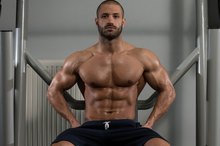Does Taking Testosterone Boosting Supplements Cause Baldness?
An estimated 25 percent of men begin balding by the age of 30, explains MedlinePlus, a service of the National Institutes of Health. Baldness generally is related to aging, heredity and testosterone. Testosterone is a hormone primarily created in the testes and used to regulate fat distribution, sperm production and bone density in men, MayoClinic.com explains 4. Low testosterone levels sometimes require testosterone supplements. Such testosterone booting supplements are available in injection, patch or gel form.
Testosterone Therapy
Testosterone therapy helps alleviate hypogonadism, or low testosterone levels. Reduced sexual desire, insomnia, increased body fat and decreased bone density are possible signs of low testosterone, MayoClinic.com explains. However, other conditions such as thyroid problems and alcohol abuse also cause similar symptoms. A blood test is necessary to determine testosterone levels conclusively. Testosterone therapy’s purported ability to benefit otherwise healthy but older men remains unsubstantiated. Although testosterone levels naturally decline at a rate of about 1 percent a year after men turn 30, supplementing the loss alleviates the natural effects of the aging process 2. There is a link between testosterone use and hair loss.
- Testosterone therapy helps alleviate hypogonadism, or low testosterone levels.
- Reduced sexual desire, insomnia, increased body fat and decreased bone density are possible signs of low testosterone, MayoClinic.com explains.
Testosterone and Baldness
What Are the Dangers of Finasteride With Testosterone?
Learn More
Testosterone is converted into dihydrotestosterone, or DHT, via an enzyme called type II 5-alpha reductase, the American Hair Loss Association explains 1. This enzyme is found in the oil glands of your hair follicles. DHT binds to receptors in scalp follicles and shrinks hair follicles. Doing so makes it difficult for healthy hair follicles to survive. So it is not your testosterone levels alone that contribute to hair loss. Instead, it is how much of the testosterone has been converted into DHT that contributes to hair loss. This hormonal process occurs in both men and women.
- Testosterone is converted into dihydrotestosterone, or DHT, via an enzyme called type II 5-alpha reductase, the American Hair Loss Association explains 1.
- Instead, it is how much of the testosterone has been converted into DHT that contributes to hair loss.
Treating Testosterone-Related Hair Loss
Medications such as minoxidil and corticosteroid injections are meant to stem the loss of hair, MayoClinic.com says 3. Finasteride is a prescription medication designed to alleviate male-pattern baldness by specifically inhibiting the conversion of testosterone into DHT. This form of hair loss medication rarely causes side effects, but finasteride sometimes decreases sex drive and impairs sexual function. Despite its benefits to men, finasteride has not been approved for use by women. If you are pregnant, avoid contact with finasteride, as exposure to this drug increases the risk of birth defects in male fetuses, the Bernstein Medical Center for Hair Restoration warns 6.
Other Side Effects of Testosterone
What Are the Benefits of Using Proviron?
Learn More
Aside from hair loss, testosterone supplements cause adverse reactions such as headaches, change in sex drive and severe allergic reaction. Testosterone supplements sometimes cause breast growth as well as changes in the size and shape of the testicles. Weight gain, urination problems and jaundice also are possible adverse reactions to testosterone use.
Related Articles
References
- American Hair Loss Association; Causes of Hair Loss; Paul J. McAndrews
- Drugs.com; Testosterone Side Effects; July 2011
- MayoClinic.com; Hair Loss; February 2010
- MayoClinic.com; Testosterone Therapy: Key to Male Vitality?; April 2010
- MedlinePlus; Hair Loss; Michael Lehrer; May 2009
- Bernstein Medical Center for Hair Restoration: Propecia (Finasteride)
- Nassar GN, Leslie SW. Physiology, Testosterone. [Updated 2018 Oct 27]. In: StatPearls [Internet]. Treasure Island (FL): StatPearls Publishing; 2019 Jan-. Available from: https://www.ncbi.nlm.nih.gov/books/NBK526128/
- Sizar O, Schwartz J. Hypogonadism. [Updated 2019 Jun 4]. In: StatPearls [Internet]. Treasure Island (FL): StatPearls Publishing; 2019 Jan-. Available from: https://www.ncbi.nlm.nih.gov/books/NBK532933/
- Stanworth RD, Jones TH. Testosterone for the aging male; current evidence and recommended practice. Clin Interv Aging. 2008;3(1):25–44. doi:10.2147/cia.s190
- McBride JA, Carson CC 3rd, Coward RM. Testosterone deficiency in the aging male. Ther Adv Urol. 2016;8(1):47–60. doi:10.1177/1756287215612961
- Kumar P, Kumar N, Thakur DS, Patidar A. Male hypogonadism: Symptoms and treatment. J Adv Pharm Technol Res. 2010;1(3):297–301. doi:10.4103/0110-5558.72420
- Johnson JM, Nachtigall LB, Stern TA. The effect of testosterone levels on mood in men: a review. Psychosomatics. 2013;54(6):509-14.
- Rajfer J. Relationship between testosterone and erectile dysfunction. Rev Urol. 2000;2(2):122–128.
- Barrett-Connor E, Dam TT, Stone K, et al. The association of testosterone levels with overall sleep quality, sleep architecture, and sleep-disordered breathing. J Clin Endocrinol Metab. 2008;93(7):2602–2609. doi:10.1210/jc.2007-2622
- Beauchet O. Testosterone and cognitive function: current clinical evidence of a relationship. Eur J Endocrinol. 2006;155(6):773-81.
- Golds G, Houdek D, Arnason T. Male Hypogonadism and Osteoporosis: The Effects, Clinical Consequences, and Treatment of Testosterone Deficiency in Bone Health. Int J Endocrinol. 2017;2017:4602129. doi:10.1155/2017/4602129
- Grossmann M, Thomas MC, Panagiotopoulos S, et al. Low testosterone levels are common and associated with insulin resistance in men with diabetes. J Clin Endocrinol Metab. 2008;93(5):1834-40.
- Cai Z, Xi H, Pan Y, et al. Effect of testosterone deficiency on cholesterol metabolism in pigs fed a high-fat and high-cholesterol diet. Lipids Health Dis. 2015;14:18. Published 2015 Mar 7. doi:10.1186/s12944-015-0014-5
- Ferrucci L, Maggio M, Bandinelli S, et al. Low testosterone levels and the risk of anemia in older men and women. Arch Intern Med. 2006;166(13):1380–1388. doi:10.1001/archinte.166.13.1380
- Nassar GN, Leslie SW. Physiology, Testosterone. [Updated 2018 Oct 27]. In: StatPearls [Internet]. Treasure Island (FL): StatPearls Publishing; 2019 Jan-.
- Rivas AM, Mulkey Z, Lado-Abeal J, Yarbrough S. Diagnosing and managing low serum testosterone. Proc (Bayl Univ Med Cent). 2014;27(4):321–324. doi:10.1080/08998280.2014.11929145
- Kanakis GA, Nieschlag E. Klinefelter syndrome: more than hypogonadism. Metab Clin Exp. 2018;86:135-144.
- Sizar O, Schwartz J. Hypogonadism. [Updated 2019 Jun 4]. In: StatPearls [Internet]. Treasure Island (FL): StatPearls Publishing; 2019 Jan-.
- Nahata L, Yu RN, Bhasin S, Cohen LE. Management of testosterone therapy in adolescents and young men with hypogonadism: are we following adult clinical practice guidelines?. J Pediatr Endocrinol Metab. 2015;28(5-6):635-40.
- McBride JA, Carson CC, Coward RM. Diagnosis and management of testosterone deficiency. Asian J Androl. 2015;17(2):177–186. doi:10.4103/1008-682X.143317
- Crawford ED, Poage W, Nyhuis A, et al. Measurement of testosterone: how important is a morning blood draw?. Curr Med Res Opin. 2015;31(10):1911-4.
- Wersinger SR, Haisenleder DJ, Lubahn DB, Rissman EF. Steroid feedback on gonadotropin release and pituitary gonadotropin subunit mRNA in mice lacking a functional estrogen receptor alpha. Endocrine. 1999;11(2):137-43.
- Rhoden EL, Estrada C, Levine L, Morgentaler A. The value of pituitary magnetic resonance imaging in men with hypogonadism. J Urol. 2003;170(3):795-8.
- Snyder PJ, Kopperdahl DL, Stephens-Shields AJ, et al. Effect of Testosterone Treatment on Volumetric Bone Density and Strength in Older Men With Low Testosterone: A Controlled Clinical Trial [published correction appears in JAMA Intern Med. 2017 Apr 1;177(4):600] [published correction appears in JAMA Intern Med. 2019 Mar 1;179(3):457]. JAMA Intern Med. 2017;177(4):471–479. doi:10.1001/jamainternmed.2016.9539
- Huo S, Scialli AR, McGarvey S, et al. Treatment of Men for "Low Testosterone": A Systematic Review. PLoS One. 2016;11(9):e0162480. Published 2016 Sep 21. doi:10.1371/journal.pone.0162480
- Armamento-Villareal R, Aguirre LE, Qualls C, Villareal DT. Effect of Lifestyle Intervention on the Hormonal Profile of Frail, Obese Older Men. J Nutr Health Aging. 2016;20(3):334–340. doi:10.1007/s12603-016-0698-x
- American Urological Association. Evaluation and management of testosterone deficiency.
- Grech A, Breck J, Heidelbaugh J. Adverse effects of testosterone replacement therapy: an update on the evidence and controversy. Ther Adv Drug Saf. 2014;5(5):190–200. doi:10.1177/2042098614548680
- American Urological Association, Evaluation and Management of Testosterone Deficiency.
- Fillo J, Breza J Jr, Ondrusova M, Luha J, Ondrus D, Dubravicky J, et al. Results of long term testosterone replacement therapy in men with abdominal obesity, erectile dysfunction and testosterone deficiency. Bratisl Lek Listy. 2018;119(9):577-580. doi:10.4149/BLL_2018_061
- Tremellen K, McPhee N, Pearce K, Benson S, Schedlowski M, Engler H. Endotoxin-initiated inflammation reduces testosterone production in men of reproductive age. Am J Physiol Endocrinol Metab. 2018 Mar 1;314(3):E206-E213. doi:10.1152/ajpendo.00279.2017. Epub 2017 Nov 28.
Writer Bio
Joseph Pritchard graduated from Our Lady of Fatima Medical School with a medical degree. He has spent almost a decade studying humanity. Dr. Pritchard writes as a San Francisco biology expert for a prominent website and thoroughly enjoys sharing the knowledge he has accumulated.









